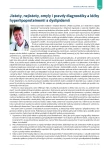Fibrates in 2018: story goes on
Authors:
Richard Češka; Michal Vrablík; Tomáš Štulc
Authors‘ workplace:
Centrum preventivní kardiologie, III. interní klinika 1. LF UK a VFN v Praze
Published in:
AtheroRev 2018; 3(3): 161-168
Category:
Reviews
Overview
At present, pharmacological intervention for dyslipidemia (DLP) is primarily aimed at the effect of LDL-C statins. In monotherapy then possibly in combination with ezetimibe (or, most modernly, with PCSK9-inhibitors). For atherogenic dyslipidemia, in particular in the context of type 2 diabetes (DM2T) or possibly the metabolic syndrome, statin-fibrate combination can be used. Atherogenic dyslipidemia refers to elevated levels of triglycerides along with lower levels of HDL-cholesterol (and change in the quality of LDL particles in favour of the “small dense” ones). Epidemiological development, new findings concerning significance of atherogenic dyslipidemia and possibilities of its influencing have led to the formulation of consensus by European experts on this issue. Atherogenic dyslipidemia regularly accompanies conditions associated with insulin resistance. It is totally irrelevant whether we use the terms metabolic syndrome, diabetic dyslipidemia or cardiometabolic risk. The treatment is based on rigorous adjustment of diet and regimen. As mentioned above, pharmacotherapy is based on statins. Fenofibrate combination should be considered for patients with persistent hypertriglyceridemia and unsatisfactory management of non-HDL-C. This brings further decrease in the risk for macrovascular as well as microvascular complications in such condition. Positive effects, in particular due to fenofibrate, can be observed mainly in patients with diabetes. The aim of this report is to provide an up-to-date overview of possibilities of utilizing fibrates with regard to the conditions of actual Czech practice which basically keeps using fenofibrate only even in the early 21st century.
Key words:
atherogenic dyslipidemia, diabetic dyslipidemia, fenofibrate , non-HDL-cholesterol, statins
Received: 10. 9. 2018
Accepted: 1. 10. 2018
Sources
- expert consensus meeting on the role of fenofibrate-statin combination therapy. Atheroscler Suppl 2015; 19 : 1–12. Dostupné z DOI: <http//doi: 10.1016/S1567–5688(15)30001–5>.
- Bruckert E, Labreuche J, Deplanque D et al. Fibrates effect on cardiovascular risk is greater in patients with high triglyceride levels or atherogenic dyslipidemia profile: a systematic review and meta-analysis. J Cardiovasc Pharmacol 2011; 57(2): 267–72. Dostupné z DOI: <http://doi: 10.1097/FJC.0b013e318202709f>.
- Catapano AL, Reiner Z, De Backer G et al. ESC/EAS Guidelines for the management of dyslipidaemias The Task Force for the management of dyslipidaemias of the European Society of Cardiology (ESC) and the European Atherosclerosis Society (EAS). Atherosclerosis 2011; 217(1): 3–46.
- Češka R, Kvasnička T, Haas T et al. Ciprofibrát v léčbě kombinované hyperlipoproteinémie. Výsledky u více než 600 nemocných z 23 center v ČR. Vnitř lék 2000; 46(3): 157–196.
- Foucher C, Aubonnet P, Reichert P et al. New fixed-dose combinations of fenofibrate/simvastatin therapy significantly improve the lipid profile of high-risk patients with mixed dyslipidemia versus monotherapies. Cardiovasc Ther 2015; 33(6): 329–337. Dostupné z DOI: <http//doi: 10.1111/1755–5922.12148>.
- Fruchart JC et al. Consensus for the use of fibrates in the treatment of dyslipoproteinemia and coronary heart disease. Am J Cardiol 1998; 81(7): 912–917.
- Gaede P, Pedersen O. Intensive integrated therapy of type 2 diabetes: implications for long-term prognosis. Diabetes 2004; 53(Suppl 3): S39–47.
- Ginsberg HN, Elam MB, Lovato LC et al. ACCORD Study Group. Effects of combination lipid therapy in type 2 diabetes mellitus. N Engl J Med 2010; 362(17): 1563–1574. Dostupné z DOI: <http//doi: 10.1056/NEJMoa1001282>.
- IDF Clinical Guidelines Task Force. Global guideline for Type 2 diabetes. 2012. Dostupné z WWW: <https://www.idf.org/e-library/guidelines/79-global-guideline-for-type-2-diabetes>.
- Keech A, Simes RJ, Barter P et al. The FIELD study investigators. Effects of long-term fenofibrate therapy on cardiovascular events in 9795 people with type 2 diabetes mellitus (the FIELD study): randomised controlled trial. Lancet 2005; 366(9500): 1849–1861. Dostupné z DOI: <http//doi: 10.1016/S0140–6736(05)67667–2>.
- NICE clinical guideline 87. March 2010. Dostupné z WWW: <http://www.acdiabetis.org/docs/consens/NICE_Clinical%20Guideline_87_T2D_2009.pdf>.
- Rajamani K, Colman PG, Li LP et al. FIELD study investigators. Effect of fenofibrate on amputation events in people with type 2 diabetes mellitus (FIELD study): a prespecified analysis of a randomised controlled trial. Lancet 2009; 373(9677): 1780–1788. Dostupné z DOI: <http//doi: 10.1016/S0140–6736(09)60698-X>.
- Reyes-Soffer G, Ngai CI, Lovato L et al. Effect of combination therapy with fenofibrate and simvastatin on postprandial lipemia in the ACCORD lipid trial. Diabetes Care 2013; 36(2): 422–428. Dostupné z DOI: <http//doi: 10.2337/dc11–2556>.
- Sacks FM, Carey VJ, Fruchart JC. Combination lipid therapy in type 2 diabetes. N Engl J Med 2010; 363(7): 692–694. Dostupné z DOI: <http//doi: 10.1056/NEJMc1006407>.
- Soška V, Vaverková H, Vrablík M. Stanovisko výboru ČSAT k doporučením ESC/EAS z roku 2011. Vnitř Lék 2013; 59(2): 120–126.
- Staels B, Dallongeville J, Auwerx J et al. Mechanism of action of fibrates on lipid and lipoprotein metabolism. Circulation 1998; 98(19): 2088–2093.
- Tenenbaum A, Fishman EZ. Fibrates are an essential part of modern anti-dyslipidemic arsenal: spotlight on atherogenic dyslipidemia and residual risk reduction. Cardiovasc Diabetol 2012; 11 : 125. Dostupné z DOI: <http//doi: 10.1186/1475–2840–11–125>.
- UK Prospective Diabetes Study (UKPDS) Group. Intensive blood-glucose control with sulphonylureas or insulin compared with conventional treatment and risk of complications in patients with type 2 diabetes (UKPDS 33). Lancet 1998; 352(9131): 837–853.
- Vamecq J, Latruffe N. Medical significance of peroxisome proliferator-activated receptors. Lancet 1999; 354(9173): 141–148. Dostupné z DOI: <http//doi: 10.1016/S0140–6736(98)10364–1>.
- Varbo A, Freiberg JJ, Nordestgaard BG. Extreme nonfasting remnant cholesterol vs extreme LDL cholesterol as contributors to cardiovascular disease and all-cause mortality in 90000 individuals from the general population. Clin Chem 2015; 61(3): 533–543. Dostupné z DOI: <http//doi: 10.1373/clinchem.2014.234146>.
- Watts GF, Dimmitt SB. Fibrates, dyslipoproteinemia and cardiovascular disease. Curr Opin Lipidol 1999; 10(6): 561–574.
Labels
Angiology Diabetology Internal medicine Cardiology General practitioner for adultsArticle was published in
Athero Review

2018 Issue 3
Most read in this issue
- Fibrates in 2018: story goes on
- Statins, brain and cholesterol: is it going together?
- Anorexia nervosa and lipid metabolism disorders
- Lysosomal storage disorders as the cause of dyslipoproteinemia
